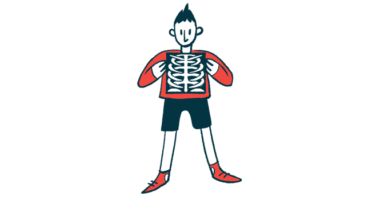Rear foot pain found more often in EDS than other rheumatic diseases
Foot problems seen to affect women's physical, mental quality of life

Women with hypermobile Ehlers-Danlos syndrome (hEDS) experience rear foot pain — pain in the back of the heel — more frequently than do those with rheumatoid arthritis (RA) or systemic lupus erythematosus (SLE), two other rheumatic diseases, a new study reported.
In addition, ankle pain was found to correlate with worse quality of life in women with EDS and RA.
“Specific foot problems … are involved in foot discomfort and pain that limit the willingness of people with EDS to maintain their standing posture or walk for prolonged times, which significantly affects their quality of life,” the researchers wrote.
“From a clinical point of view, the prevention of deformities through foot orthoses [braces or other devices] that … cushion the areas with high pressure and stabilize the foot could significantly improve the quality of life of these patients,” the team added.
The study, “Foot Pain and Disability in Women with Rheumatoid Arthritis, Ehlers–Danlos Syndrome and Systemic Lupus Erythematosus: Relationship with Quality of Life,” was published in the Journal of Clinical Medicine.
Study involved more than 200 women with foot pain
EDS affects connective tissues that support the joints, skin, blood vessels, and other tissues and organs. Foot issues, including pain, affect most people with Ehlers-Danlos, and specifically hEDS, the most common type of the disease. As a result, patients experience problems while standing or walking, impairing their daily activities and health-related quality of life, known as HRQoL.
Clinical manifestations in the feet also occur in patients with RA and SLE. However, “there are no previous studies that compare foot characteristics and their impact on the quality of life in women with [RA], EDS and SLE,” the researchers noted.
To learn more, a team at the University of Seville, in Spain, conducted a cross-sectional analysis — which looks at data at a single point in time — of women with hEDS, RA, and SLE. Participants were recruited between January 2016 and July 2022 from three hospitals in Seville and several patient associations. Women without any rheumatic disease but with foot pain served as a control group.
In total, 156 women with a rheumatic disorder and 47 women without one were involved in the analysis. This included 56 women with RA (mean age 59.6 years), 48 with hEDS (41.7 years), and 52 with SLE (47 years).
Women with hEDS tended to have a lower body mass index or BMI, a ratio of weight to height, with an average of 23.5 kilograms per square meter, or kg/m2. In comparison, women with RA averaged 26.6 kg/m2, while those with SLE averaged 28 kg/m2. The control group had a mean BMI of 26.5 kg/m2.
Moreover, those with hEDS averaged 2.2 years since their diagnosis, compared with 14.8 years among participants with RA and 15.7 among those with SLE.
Effects of pain seen on physical, mental quality of life
Foot pain was similar between the different groups when measured with the 11-point Numeric Range Scale, which rates pain on a scale of 0 to 10, and the number of days per week the women experienced pain. However, those with rheumatic diseases showed more foot pain and disability than the controls when measured with the foot function index and the Manchester foot pain and disability index. Both scales range from 0 to 100, with higher scores indicating greater pain and disability.
hEDS patients showed significantly worse mental quality of life than SLE patients, as measured by the 12-Item Short Form Survey. Both physical and mental HRQoL were worse in hEDS and RA patients than in controls.
Regarding foot pain location, rear foot pain was significantly more frequent in women with Ehlers-Danlos, whereas ankle pain and toe deformities were more common in those with RA. The percentage of women with pain at the front of their feet did not differ between the disease groups.
RA patients also had lower arches in their feet than the other participants.
Statistical analysis showed that BMI and ankle pain were linked to quality of life in both the hEDS and RA groups. Older age also correlated with worse quality of life in RA.
Overall, these findings show that while no differences in foot posture were seen between the groups, “women with RA, EDS, SLE and foot pain perceive worse HRQoL,” the researchers wrote.
They added that although footwear was not considered in this study, use of inappropriate shoes and their impact on foot problems should be analyzed in future studies. This factor could adversely affect EDS patients prior to diagnosis, “as foot involvement occurs in early disease,” they noted.







